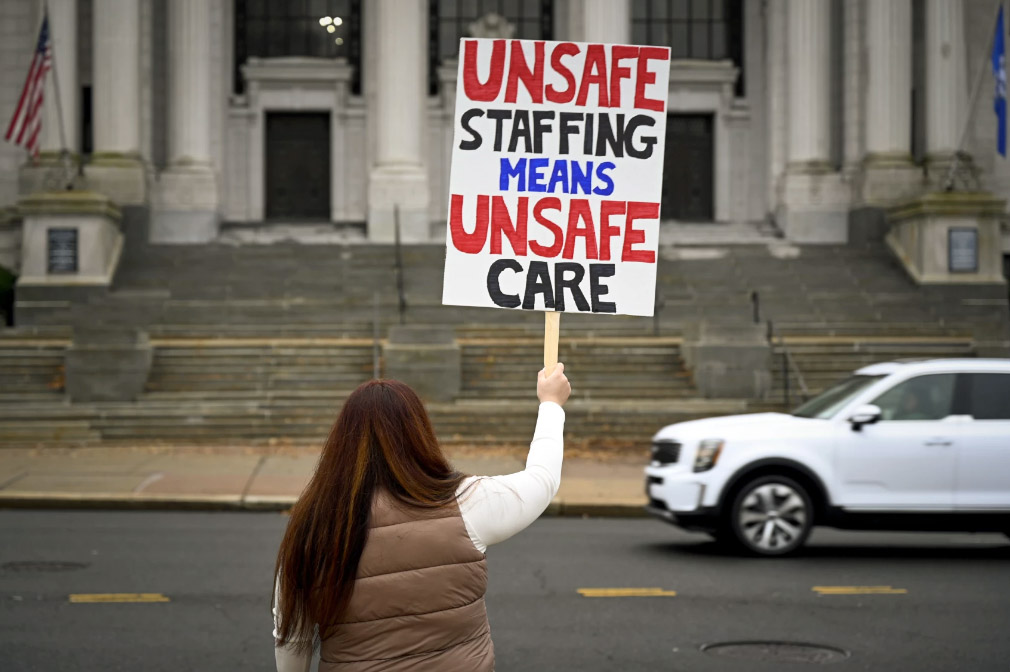Not long ago, you couldn’t drive more than a few miles without seeing a sign or poster thanking our frontline workers for their efforts in the face of the COVID-19 pandemic. Many of these frontline workers were nurses.
While most of our society was sheltering in place, my fellow nurses and I were seeing patients with a disease we didn’t fully understand. In hospitals, they were working overtime with minimal staff, overcrowded units and medical supplies far beyond their expected lifespan.
In nursing homes, despite their best efforts, my colleagues had to stand helpless while dozens of their patients succumbed to COVID. During the pandemic, I have also seen many nurses simply walk away from the bedside out of frustration and exhaustion. Now that the tidal wave of the pandemic has passed, we must do our best to care for those heroes who have worked tirelessly and selflessly to take care of us.
As a registered nurse with 15 years of experience in skilled nursing (retirement homes), acute care (hospitals) and home care, I have had the privilege of caring for patients throughout our state and in various settings/health conditions. The one thing I’ve noticed in all of these contexts is that we never have enough staff.
This shortage or lack of staff was most evident when I worked in skilled nursing facilities (retirement homes). According to the latest Connecticut State Census, we have over 24,400 nursing home beds in that state. And they hold some of our most fragile and helpless patients. In contrast, we only have 8,700 hospital beds. Our nursing home patients make up the bulk of the state’s hospitalized population.
Starting in 2021, our state has required every patient in a nursing home to receive three hours a day of direct patient care. Before that, it was only 1.9 hours a day and hadn’t been updated for nearly 30 years. Direct patient care is a combination of care provided by Registered Nurses (RNs), Licensed Practical Nurses (LPNs), and Certified Practical Nurses (CPNs).
Three hours, combined. That’s it. To assess, provide medication, personal care, help with dressing, feeding and the myriad of other activities necessary for the well-being of patients who can rely on the staff for almost everything. A respiratory treatment can take 15 to 20 minutes for a nurse to administer alone. Some patients need three to four treatments per day. Every moment of care given to one patient diminishes the care available to others.
A study by the Centers for Medicare & Medicaid Services in 2001 found that nursing home patients require a minimum of 4.1 hours of direct patient care. Many states have based their staffing needs on this study and there is currently a bill (SB 989) that seeks to increase our state minimum to 4.1 hours of care per day. Although this is an improvement, please consider the age of this study.
I started my career in 2007. The acuity and care required for patients admitted to skilled nursing facilities has changed significantly since then. Hospitals are releasing patients faster and with far more complicated health issues than they ever have in the past. Even if this bill passes, we will be basing our staffing expectations on a 20-year-old study. Our seniors deserve better. Our heroes deserve better.
Currently, another bill is gaining traction in our state, SB 1067, which will address nurse staffing levels in acute care facilities (hospitals). I support this bill, but in order to address staffing issues in acute care facilities, I implore you to remember the issues of labor in specialty care facilities. We take care of your parents, your grandparents and in rare cases, your children. We do this without the multidisciplinary support or resources found in acute care settings. And currently, the facilities we work in are only required to provide these patients with three hours of care per day.
This is simply not enough to adequately meet even the simple medical needs of every patient. If you’re in doubt, let me explain what three hours of care a day looks like. For the hours of 7-3 and 3-11, there will be one registered nurse supervisor for 128 patients, one registered nurse for 33 patients, one registered nurse for 10-11 patients. Overnight from 11-7, there will be only one supervising nurse, one unit nurse for 64 patients and one CNA for 16 patients. Please contemplate this for a moment. Our most fragile patients who are least likely to care for themselves or defend themselves receive only 7.5 minutes of care per hour.
Please don’t forget us. We are here and we work tirelessly to provide safe and compassionate care for your loved ones and those who have no one to protect them. We need more staff, and we need them now, before we face another pandemic.
A 2020 study by Harrington et al found that nurse staffing levels in skilled nursing facilities have a direct impact on patient well-being and medical outcomes. The same authors also found that it is not enough to simply measure nursing hours per day. Staffing guidelines and expectations should be based on patient acuity and actual needs.
As we have supported you and your loved ones through your darkest hours, please support us and help us improve the care we provide to our patients. Please support SB 989 and any other efforts to improve nursing staffing levels. You can help by writing or calling your state representative.
If you are a nurse or know a nurse who has touched your life and would like to share this story with your legislator in support of national legislation, please visit RNAction.org and click “Take Action”. You can simply enter your mailing address and your story or comment will automatically be forwarded to your representatives. It will only take a moment and could mean all the difference to nurses and patients in our state.
Kenneth Elyosius Jr. is a nurse working at a nursing home here in Connecticut. He is currently working on his master’s degree at the University of Connecticut in the Family Nurse Practitioner (FNP) program.


